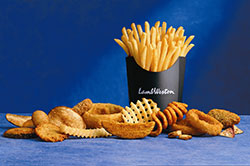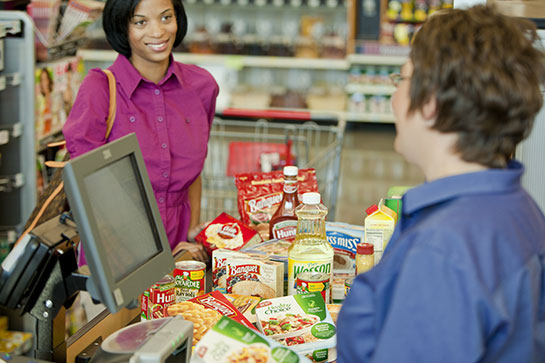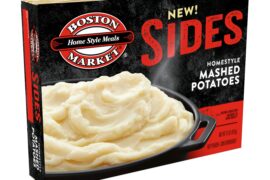First the good news: the Lamb Weston potato products unit of ConAgra Foods posted volume and profit growth, as well as productivity initiatives, that helped offset crop quality challenges. Furthermore, international sales advanced at a double-digit rate.
 Overall sales in the Commercial Foods segment (which includes baked goods, ingredients and packaged food items as well as Lamb Weston french fries and other value-added potato products marketed primarily to foodservice operators) for the Omaha, Nebraska, USA-headquartered parent company rose 1% to $1.63 billion during the fourth quarter of fiscal year 2014, which ended on May 25.
Overall sales in the Commercial Foods segment (which includes baked goods, ingredients and packaged food items as well as Lamb Weston french fries and other value-added potato products marketed primarily to foodservice operators) for the Omaha, Nebraska, USA-headquartered parent company rose 1% to $1.63 billion during the fourth quarter of fiscal year 2014, which ended on May 25.
Now the bad news: Weak volumes in the Consumer Foods sector (which includes the company’s numerous frozen food retail brands as well as Chef Boyardee canned goods, Orville Redenbacher’s popcorn and other household name products) resulted in sales and profitability declines of 7% to $1.8 billion and $177 million, respectively.
More bad news: The Private Brands segment posted a loss of $573 million, due largely to price cutting and higher than anticipated operating costs. Quarterly dollar volume of approximately $1 billion, however, was in line with year-ago sales.
Bottom line: Total revenue slipped 3% to $4.43 billion.
“We are disappointed with fiscal 2014 overall, and we have a very focused sense of urgency directed toward improving our results. Despite this difficult year, we were able to generate substantial cash, meet our debt reduction commitments, and pay a strong dividend,” stated CEO Gary Rodkin.
 The chief executive convened a meeting with other senior officers of the company to explain reasons for the results in greater detail during a fourth quarter conference call on June 26. He minced no words about the relatively poor health of the once high-flying Healthy Choice brand.
The chief executive convened a meeting with other senior officers of the company to explain reasons for the results in greater detail during a fourth quarter conference call on June 26. He minced no words about the relatively poor health of the once high-flying Healthy Choice brand.
“One of the softest categories is healthy meals, which obviously impacts Healthy Choice,” said Rodkin. “The frozen healthy meal segment is a big, important area within frozen single-serve meals at $2.5 billion in annual retail sales, comparable to the hot dog category. This particular part of frozen single-serve meals has seen the biggest drop in sales. There is plenty of room for better performance in a category this big by gaining share via differentiated product.
“In terms of specific initiatives, we have started improving product mix, meaning moving to more of our proprietary Cafe Steamers offerings and discontinuing a number of other Healthy Choice slow moving SKUs. Those discontinuations are contributing to the brand’s current volume declines, and that will continue in the first quarter of fiscal 2015, but better volume performance should start to show in the second quarter.
“For context, Cafe Steamers is a truly differentiated product line, has proven staying power, and has good margins. So growing that specific product line is good all around for our results.”
He continued: “In the overall frozen category, consumer buying is down, but we are taking share in single-serve meals. We continue to be a strong player there overall, and we saw good share performance as well as volume growth during the quarter, from Marie Callender’s and Bertolli.
“Of course, the volume declines have weighed on profits in Consumer Foods. For the fourth quarter, adjusted operating profit of $268 million was 3% below the comparable $275 million last year. The impact of the volume decline on profit was lessened by cost savings in excess of inflation, as well as lower advertising and promotion expenses.”
During the question and answer session of the conference call, Rodkin and key members of his executive team fielded queries from stock market analysts. Andrew Lazar of Barclays Capital, noting that the branded business has decelerated significantly, suggested that this should have been expected since SKUs (stock keeping units) have been reduced in stores.
Tom McGough, president of ConAgra’s Consumer Foods division, replied: “The challenge that many manufacturers face, including ourselves, is that there is more competition for the limited space in stores. And certainly what we have seen is a lower lift as a result of that.”
“In frozen,” he continued, “there has been an increase of overall competitive activity. We have bolstered our support. We have been competitive in our programs, and our market shares, primarily in the premium and value segments with Marie Callender’s, Bertolli and Banquet, for the fiscal year are up both in terms of volume and dollar share. We feel like we have struck the right balance there, and those are businesses that we will continue to invest in.”

Ken Golden of J.P. Morgan wanted to know to what extent SKU reductions in Healthy Choice resulted from ConAgra decisions to focus more on higher growth products, rather than from delistings by supermarket operators.
“That is totally us. And it’s not to say that they don’t have a little bit to do with each other, because velocity is what really counts and shelf space is valuable,” answered Rodkin. “But this is something we have been very proactively tackling over the last 12 months or so, because we do have a very strong piece of that business.
“Our sub-line of Cafe Steamers continues to grow very strongly, because it’s extremely different in the marketplace, and that continues to grow. So we are very consciously culling other sub-lines and slow-moving SKUs to give more prominence and more focus to the Cafe Steamers line, and that has been a very big portion of why the volume is down. Once we reach the kind of shelf placement that we want, I think we will start to see better performance in Healthy Choice.”
Meanwhile, McGouch pointed out that the company is redoubling efforts to further penetrate growing channels of distribution beyond traditional retail sectors of supermarkets and grocery stores.
“Whether it’s Club, Dollar, or C-Store, they are growing at a much faster rate than traditional grocery,” he said. “Over the last year, we have worked, customized our product, packaging and merchandising programs to succeed in those classes of trade. We are well positioned, going into fiscal year 2015, to see a market improvement in our top line as a result of that.”
Private Label Prospects
As for the ConAgra’s major expansion into the private label business in 2012, when it bought Saint Louis, Missouri-headquartered Ralcorp for approximately $4.95 billion, the transition has not been easy.
Rodkin admitted that the company unfortunately “dug itself into a hole” during the first year of the acquisition. “We have had to be very reactive in putting out fires and trying to basically maintain our customer relationships. That’s pretty much behind us,” he said.
Paul Maass, ConAgra’s president of Private Brands and Commercial Foods, elaborated: “Integration itself was challenging. And when you have a situation where your customers are really motivated to change suppliers, because we are letting them down on service and execution issues, you have to really pull the price lever to maintain the volumes. We are now in a much more stable position, having fixed service and execution issues.”
There was a bit of buzz among some analysts who thought that ConAgra might consider breaking up the company to maximize shareholder value, or perhaps, as Eric Katzman of Deutsche Bank proposed: “Why not manage [brand] businesses for more cash to fund growth in private label?”
Rodkin’s response to that notion was as follows: “We have built into our guidance, realistic growth expectations, and we do segment our businesses, and as we see rationale for moving things into more of a managed-for-cash mode, which we do in a number of our businesses. So I would tell you that the fixes that we have in place on those three problem brands, really are pretty tactical right now, and they really have to prove their mettle with a very high bar to go get any kind of significant marketing investment from this point forward. That may be a slightly different way of saying, we are looking at things a bit like you’re suggesting.”
So, what are analysts suggesting about ConAgra stock, post-conference call? Hawkinvest posted a rather positive summary on the seekingalpha.com website, highlighted as follows:
“After an earnings warning/miss, ConAgra shares are oversold and cheap. They are likely to rebound soon, and now offer a juicy 3.5% yield. Merger and acquisition deals in the food sector have been active, and that also suggests ConAgra shares are now too cheap to ignore. Compared to other food stocks, ConAgra appears to be a bargain.”





